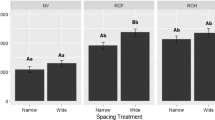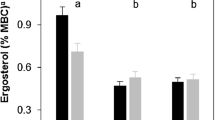Abstract
Soil transfers, presumed to contain mycorrhizal fungal inoculum from a native plant community, were applied to rooted cuttings and volunteer plants of Populus balsamifera L. to improve their growth on an abandoned mined site in south central Alaska. The objectives of the study were to determine (1) if these soil transfers could be substituted for additional P fertilizer when applied with a base level of NP fertilizer to improve growth, and (2) if P added to treatments receiving a base level of NP fertilizer and soil transfer would suppress mycorrhizal formation. Physical dimensions of plants were measured near the beginning and end of each of two growing seasons. Several plants per plot were harvested at the end of year 2 to determine mycorrhizal formation, current growth, and leaf nutrient concentrations. Plant height was significantly increased only when soil transfer and additional P treatments were combined. Response to additions of P fertilization alone or soil transfer alone were not significantly different from each other. Current twig growth increased with either treatment alone or both combined. Soil transfer on cuttings resulted in more ectomycorrhizal formation than either the control or additional P. Leaf N concentrations on cuttings and volunteers increased when plants were treated with soil transfer. Similar growth responses were achieved by soil transfers or additional P, but mycorrhizal formation was improved with the soil transfer treatments. P added to the base level plus soil transfer did not suppress or improve mycorrhizal formation compared to that with soil transfer alone.
Similar content being viewed by others
References
Aldon EF (1975) Endomycorrhizae enhance survival and growth of fourwing saltbush on coal mine spoils. (USDA Forest Service Research Note RM-294) Rocky Mountain Forest Range Experiment Station, Fort Collins, Colo
Allen EB (1984) VA mycorrhizae and colonizing annuals: implications for growth, competition, and succession. In: Williams SE, Allen MF (eds) VA mycorrhizae and reclamation of arid and semi-arid lands. Wyoming Agricultural Experiment Station, University of Wyoming, Laramie, pp 42–52
Allen EB, Allen MF (1980) Natural re-establishment of vesicular-arbuscular mycorrhizae following stripmine reclamation in Wyoming. J Appl Ecol 17:139–147
Allen EB, Allen MF (1990) The mediation of competition by mycorrhizae in successional and patchy environments. In: Grace J, Tilman D (eds) Perspectives on plant competition. Academic Press, London, pp 367–389
Allen EB, Chambers JC, Connor KF, Allen MF, Brown RW (1987) Natural re-establishment of mycorrhizae in disturbed alpine ecosystems. Arct Alp Res 19:11–20
Allen MF (1984) Physiology of mycorrhizae: a key to understanding successful plant establishment. In: Williams SE, Allen MF (eds) VA mycorrhizae and reclamation of arid and semi-arid lands. Wyoming Agricultural Experiment Station, University of Wyoming, Laramie, pp 69–80
Allen MF, Moore TS Jr, Christensen M, Stanton N (1979) Growth of vesicular-arbuscular-mycorrhizal and nonmycorrhizal Bouteloua gracilis in a defined medium. Mycologia 71:666–669
Allison LE (1982) Organic carbon, Walkley-Black method. In: Black CA (ed) Methods of soil analysis, part 2. (Agronomy series, no 9) American Society of Agronomy, Madison, Wis, pp 1372–1375
Amaranthus MP, Perry DA (1987) Effect of soil transfer on ectomycorrhiza formation and the survival and growth of conifer seedlings on old, nonreforested clear-cuts. Can J For Res 17:944–950
Amaranthus MP, Perry DA (1989) Interaction effects of vegetation type and Pacific madrone soil inocula on survival, growth, and mycorrhiza formation of Douglas-fir. Can J For Res 19:550–556
Amaranthus MP, Li CY, Perry DA (1990) Influence of vegetation type and madrone soil inoculum on associative nitrogen fixation in Douglas-fir rhizospheres. Can J For Res 20:368–371
Azcon R, Barea JM, Hayman DS (1976) Utilization of rock phosphate in alkaline soils by plants inoculated with mycorrhizal fungi and phosphate-solubilizing bacteria. Soil Biol Biochem 8:135–138
Bjorkman E (1970) Forest tree mycorrhiza — the conditions for its formation and the significance for tree growth and afforestation. Plant Soil 32:589–610
Bowen GD, Theodorou C (1979) Interactions between bacteria and ectomycorrhizal fungi. Soil Biol Biochem 11:119–126
Bremner JM (1965) Inorganic forms of nitrogen. In: Black CA (ed) Methods of soil analysis, part 2. (Agronomy series, no 9) American Society of Agronomy, Madison, Wis, pp 1179–1237
Bremner JM, Mulvaney CS (1982) Total nitrogen, principles. In: Black CA (ed) Methods of soil analysis, part 2. (Agronomy series, no 9) American Society of Agronomy, Madison, Wis, pp 1152–1153
Bryant JP, Kuropat PJ (1980) Selection of winter forage by subarctic browsing vertebrates: the role of plant chemistry. Annu Rev Ecol Syst 11:261–285
Call CA, McKell CM (1982) Vesicular-arbuscular mycorrhizae — a natural revegetation strategy for disposed processed oil shale. Reclam Reveg Res 1:337–247
Carling DE, Roncadori RW, Hussey RS (1989) Interactions of vesicular-arbuscular mycorrhizal fungi, root-knot nematode, and phosphorus fertilization on soybean. Plant Dis 73:730–733
Castellano MA, Molina R (1989) Mycorrhiza. In: Landis TD, Tinus RW, McDonald SE, Barnett JP (eds) The container tree nursery manual, vol 5. (Agriculture handbook 674) USDA Forest Service, Washington, DC, pp 101–167
Chapin FS III, Tryon PR, Van Cleve K (1983) Influence of phosphorus on growth and biomass distribution of Alaskan taiga tree seedlings. Can J For Res 13:1092–1098
Chapin FS III, Van Cleve K, Tryon PR (1986) Relationship of ion absorption to growth rate in taiga trees. Oecologia 69:238–242
Daft MJ, Hacskaylo E (1976) Arbuscular mycorrhizas in the anthracite and bituminous coal wastes of Pennsylvania. J Appl Ecol 13:523–531
Danielson RM (1988) Mycorrhizae in forestry: the state of the art in land reclamation. In: Lalonde M, Piché Y (ed) Canadian Workshop on Mycorrhizae in Forestry. Université Laval, Ste-Foy, Quebec, pp 39–41
Danielson RM, Visser S (1988) Ectomycorrhizae of jack pine and green alder: assessment of the need for inoculation, development of inoculation techniques and outplanting trials on oil sand tailings. Alberta Land Conservation and Reclamation Council Report No RRTAC 88-5, Edmonton
Danielson RM, Visser S (1989) Host response to inoculation and behaviour of introduced and indigenous ectomycorrhizal fungi of jack pine grown on oil-sands tailings. Can J For Res 19:1412–1421
Finlay RD, Read DJ (1986a) The structure and function of the vegetation mycelium of ectomycorrhizal plants. I. Translocation of 14C-labeled carbon between plants interconnected by a common mycelium. New Phytol 103:143–156
Finlay RD, Read DJ (1986b) The structure and function of the vegetative mycelium of ectomycorrhizal plants. II. The uptake and distribution of phosphorus by mycelial strands interconnecting host plants. New Phytol 103:157–165
Fogel R (1980) Mycorrhizae and nutrient cycling in natural forest ecosystems. New Phytol 86:199–212
Harley JL, Smith SE (1983) Mycorrhizal symbiosis. Academic Press, New York
Hayman DS (1982) Influence of soils and fertility on activity and survival of vesicular-arbuscular mycorrhizal fungi. Phytopathology 72:1119–1125
Heilman PE (1990) Growth and N status of Populus in mixture with red alder on recent volcanic mudflow from Mount Saint Helens. Can J For Res 20:84–90
Helm DJ, Carling DE (1990) Use of on-site mycorrhizal inoculum for plant establishment on abandoned mined lands. Abandoned Mined Lands Program A Mining Research Contract Report, Contract J0289003, USDI Bureau of Mines
Helm DJ, Carling DE (1993) Use of soil transfer for reforestation on abandoned mined lands in Alaska. II. Effects of soil transfers from different successional stages on growth and mycorrhizal formation by Populus balsamifera and Alnus crispa. Mycorrhiza 3:107–114
Isaac RA, Johnson WC (1976) Determination of total nitrogen in plant tissue, using a block digestor. J Assoc Off Anal Chem 59:98–100
Jackson ML (1958) Organic matter determination for soils. In: Jackson ML (ed) Soil chemical analysis. Prentice-Hall, Englewood Cliffs, NJ, pp 219–221
Janos DP (1980a) Vesicular — arbuscular mycorrhizae affect lowland tropical rain forest plant growth. Ecology 61:151–162
Janos DP (1980b) Mycorrhizae influence tropical succession. Biotropica 12:56–64
Jobidon R, Thibault J-R (1982) Allelopathic growth inhibition of nodulated and unnodulated Alnus crispa seedlings by Populus balsamifera. Am J Bot 69:1213–1223
Kormanik PP, Bryan WC, Schultz RC (1980) Procedures and equipment for staining large number of plant root samples for endomycorrhizal assay. Can J Microbiol 26:536–538
Koske RE, Halvorson WL (1981) Ecological studies of vesiculararbuscular mycorrhizae in a barrier sand dune. Can J Bot 59:1413–1422
Koske RE, Polson WR (1984) Are VA mycorrhizae required for sand dune stabilization? Bio Science 34:420–424
Li CY, Hung LL (1987) Nitrogen-fixing (acetylene-reducing) bacteria associated with ectomycorrhizae of Douglas-fir. Plant Soil 98:425–428
Lodge DJ, Wentworth TR (1990) Negative associations among VA mycorrhizal fungi and some ectomycorrhizal fungi inhabiting the same root system. Oikos 57:347–356
Marx DH (1972) Ectomycorrhizae as biological deterrents to pathogenic root infections. Annu Rev Phytolpathol 10:429–454
Marx DH, Artman JD (1989) Pisolithus tinctorius ectomycorrhizae improve survival and growth of pine seedlings on acid coal spoils in Kentucky. Reclam Rev 2:23–31
Marx DH, Cordeil CE (1988) Specific ectomycorrhizae improve reforestation and reclamation in the eastern United States. In: Lalonde M, Piché Y (eds) Canadian Workshop on Mycorrhizae in Forestry. Université Laval, Ste-Foy, Quebec, pp 75–86
Mason PA, Wilson J, Last FT, Walker C (1983) The concept of succession in relation to the spread of sheathing mycorrhizal fungi on inoculated tree seedlings growing in unsterile soils. Plant Soil 71:247–256
Mehlich A (1982) Comprehensive methods in soil testing. Mimeo-89, North Carolina Department of Agriculture, Raleigh, NC
Melin E (1953) Physiology of mycorrhizal relations in plants. Annu Rev Plant Physiol 4:325–346
Mikola P (1973) Application of mycorrhizal symbiosis in forestry practice. In: Marks GC, Kozlowski TT (eds) Ectomycorrhizae: their ecology and physiology. Academic Press, New York, pp 383–411
Olsen SR, Sommers LE (1982) Phosphorus soluble in sodium bicarbonate. In: Black CA (ed) Methods of soil analysis, part 2. (Agronomy series, no 9) American Society of Agronomy, Madison, Wis, pp 421–422
Parkinson D (1978) Microbes, mycorrhizae and mine spoil. In: Wali MK (ed) Ecology and coal resource development. Pergamon Press, New York, pp 634–642
Parkinson D (1984) Greenhouse pot studies dealing with amendation of oil sand tailings: effects of peat, sewage sludge and fertilizer on plant growth, mycorrhizae and microbial activity. In: Soil microbiology in land reclamation, vol II: Mycorrhizae. Alberta Land Conservation and Reclamation Council Report RRTAC 84-4, Edmonton
Peech M (1965) Hydrogen-ion activity. In: Black CA (ed) Methods of soil analysis, part 2. (Agronomy series, no 9) American Society of Agronomy, Madison, Wis, pp 914–926
Perry DA, Molina R, Amaranthus MP (1987) Mycorrhizae, mycorrhizospheres, and reforestation: current knowledge and research needs. Can J For Res 17:929–940
Phillips JM, Hayman DS (1970) Improved procedures for clearing roots and staining parasitic and vesicular-arbuscular mycorrhizal fungi for rapid assessment of fungi infection. Trans Br Mycol Soc 55:158–161
Pilz DP, Perry DA (1984) Impact of clear cutting and slash burning on ectomycorrhizal associatons of Douglas-fir seedlings. Can J For Res 14:94–100
Pratt PF (1965) Potassium. In: Black CA (ed) Methods of soil analysis, part 2. (Agronomy series, no 9) American Society of Agronomy, Madison, Wis, pp 1022–1030
Reeves FB, Wagner D, Moorman T, Kiel J (1979) The role of endomycorrhizae in revegetation practices in the semi-arid west. I. A comparison of incidence of mycorrhizae in severely disturbed versus natural environments. Am J Bot 66:6–13
Rothwell FM, Vogel WG (1982) Mycorrhizae of planted and volunteer vegetation on surface-mined sites. (USDA Forest Service General Technical Report NE-66) Northeastern Forest Experiment Station, Broomall, Pa
SAS Institute (1985) SAS user's guide: statistics, version 5 edn. SAS Institute, Cary, NC
SCS (1984) Procedures for collecting soil samples and methods of analysis for soil survey. USDA Soil Conservation Service Soil Survey Investigations Report No 1
Sutton JC, Sheppard BR (1976) Aggregation of sand-dune soil by endomycorrhizal fungi. Can J Bot 54:326–333
Vozzo JA, Hacskaylo E (1974) Endo-and ectomycorrhizal associations in five Populus species. Bull Torrey Bot Club 101:182–186
Williams SE, Allen MF (1984) VA mycorrhizae and reclamation of arid and semi-arid lands. (Scientific report number SA1261) Wyoming Agricultural Experiment Station, University of Wyoming, Laramie
Zak B (1973) Classification of ectomycorrhizae. In: Marks GC, Kozlowski TT (eds) Ectomycorrhizae: their ecology and physiology. Academic Press, New York, pp 43–78
Author information
Authors and Affiliations
Rights and permissions
About this article
Cite this article
Helm, D.J., Carling, D.E. Use of soil transfer for reforestation on abandoned mined lands in Alaska. Mycorrhiza 3, 97–106 (1993). https://doi.org/10.1007/BF00208917
Issue Date:
DOI: https://doi.org/10.1007/BF00208917




